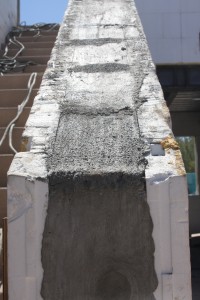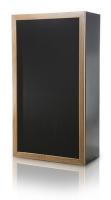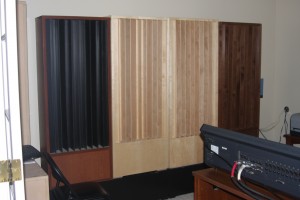Room Shell
There is much confusion these days about the two separate and distinct functions that must be assigned to our listening, recording, and home theater rooms. Our rooms are really two rooms in one and must be viewed and designed accordingly. In our music rooms, we must deal and address the sound energy that comes from other sources outside our room and we must deal with the sound energy that is created within our rooms. Both of these issues require different approaches and different sciences to maximize each of their respective functions.
Reflection, Absorption, Diffusion
With sound energy, we can only do three things. We can absorb that energy, reflect that energy, or diffuse it. We use sound absorption and diffusion technology inside our rooms, but we use reflection to keep sound generated from outside our rooms from entering our rooms. The sound energy created outside of our rooms is reflected back to the source using the proper barrier technology.
Problem Identification
Sound energy created from outside our rooms, from whatever the source, must be made to stay outside where it belongs. We accomplish this goal through a process of identification the energy issues and then applying the correct science to deal with what we have identified. We do not need to be that concerned with what is causing the sound energy from the outside of our rooms, but we do need to identify the amount of the energy and at what frequency that energy occurs at, so we can correctly apply the correct science.
Build A Wall
Once we have identified the amount of invading sound energy that is occurring from outside sources, we need to construct a barrier between the source of the noise and the inside of our rooms. If you want to stop sound pressure energy from reaching your room, you build a barrier between the source of the noise and the inside of your room. Barriers can be designed to stop just about all levels of unwanted noise, if one has the space and budget to accomplish the sound transmission loss goals.
STC – Sound Transmission Class
Barrier technology is assigned a value termed the sound transmission loss ability of a particular structure. The STC or sound transmission class rating of the barrier will determine how much energy the barrier will stop or not let through it. Concrete has a higher STC rating than frame and wood construction. This higher number means that the barrier can hold back larger amounts of sound energy. The type and STC rating of the chosen barrier technology depends on the amount of energy that we must keep out of our room environment.
Measure Twice Cut Once
It is critical to measure the amount of energy we are building our barrier against. We want to build a barrier that will accomplish our objectives without overbuilding. Every dB of energy that we must construct a barrier against cost money. Our barrier must achieve the desired result without breaking the bank. We need just enough barrier to stop the noise, without over spending. Testing noise levels over different time frames is the only sure way of assigning the correct barrier to the noise level and not over spending.
Sound Absorption/Sound Diffusion
The inside of our rooms requires the use of sound absorption and diffusion technologies. The inside of our rooms are pressure chambers. Sound is interjected into our rooms with speakers, vocals, and instruments. The size and volume of our rooms determines how all of that energy will behave or not behave. Some wavelengths will fit into your room, some will try and fit, but will tell you when they don’t.
Low Frequency Issues
Low frequency energy is the most problematic of all the frequencies within our room because of its long wavelengths. Long wavelengths need long spaces to run in. If they do not have the required space to move around, they get mad and produce resonances. Resonances are low frequencies way of expressing their discontent with the room size one has placed them within.
Sound Absorption
To manage the excess energy from within our rooms, we use sound absorption. We can absorb low, middle, and high frequencies. Low frequency energy is the most destructive and the hardest to absorb. It requires larger and more powerful sound absorbing technologies placed at certain locations within our rooms. Low frequency resonances can build up in room corners, and all room boundary intersections such as the ceiling and wall, floor and wall intersections.
Room Boundary Reflections
Reflections from sound energy from our room boundary surfaces are our biggest issue within our listening and recording rooms. Room boundary reflections can interfere with the direct sound from our monitors and can cause distortion at the microphone positions. To manage these reflections and reduce their impact, we can use sound absorption or sound diffusion technologies. Sound absorption reduces the signal by changing sound energy into heat. Sound diffusion will take the reflection and spread it out into a series of smaller reflections.
Two Schools Of Thought
When we think of our listening, home theater, and professional recording studio rooms, we must think about different technologies. We must think barrier technology to keep unwanted sound energy generated from the outside of our room, outside where it belongs. We will build a barrier to reflect the unwanted sound energy back to its source. The sound energy produced within our rooms will be kept inside our rooms with the use of barrier technology, but we will use sound absorption and sound diffusion to manage low frequency resonances and middle and high frequency reflections from our interior wall boundary surfaces that sound producing sources with our rooms generate.









The discussion on ductwork noise transmission from Acoustic Fields highlights crucial aspects of HVAC system acoustics. The movement of air…
Great build plans. thank you Denis
You must use absorption. Never place a chair against a wall.
A friend and I built several diffusors using these plans and they turned out absolutely beautiful. Very good instructions and…